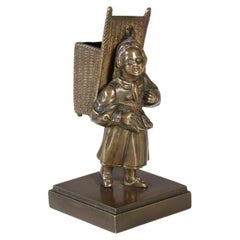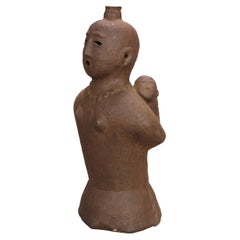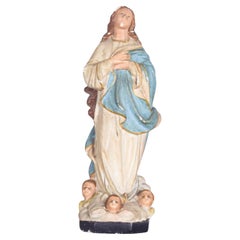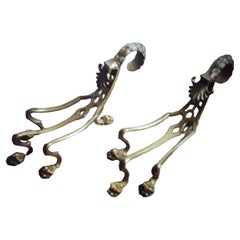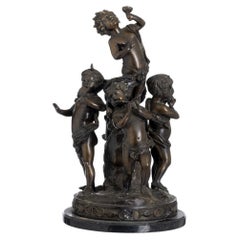Figurative Sculptures on Sale
to
2,060
85
72
165
414
1,481
157
328
551
300
69
20
73
88
52
91
104
99
57
37
345
224
97
97
89
57
50
36
22
20
19
9
6
6
4
4
1
1
949
564
528
421
417
1,324
758
1,313
429
388
337
289
Height
to
Width
to
2,217
2,170
2,188
13
11
11
11
9
Sale Items
Small Antique Bronze Sculpture, Late 19th Century, Kiepenkerl, Farmer Girl
Located in Greven, DE
Beautiful, small bronze figure, probably a holder for matches.
The pannier on the back of the sculpture can be used to store small items. For examp...
Category
Antique Late 19th Century Unknown Figurative Sculptures
Materials
Bronze
$340 Sale Price
25% Off
Antique Japanese Pottery Effigie Sculpture of a Woman & Child 18thC
Located in Big Flats, NY
Antique Japanese Pottery Effigie Sculpture of a Woman & Child 18thC
Measures- 11" H x 5.75" W x 4.25" D;
Category
Antique 18th Century Japanese Figurative Sculptures
Materials
Pottery
$600 Sale Price
20% Off
Portuguese Sculpture of Nossa Senhora da Imaculada Conceição
Located in Lisboa, Lisboa
This Portuguese sculpture of Nossa Senhora da Imaculada Conceição is a captivating religious piece, crafted in plaster with delicate attention to detail. The figure depicts the Virgi...
Category
Antique Late 19th Century Portuguese Rococo Figurative Sculptures
Materials
Plaster
$459 Sale Price
65% Off
19thc Antique Petit British Bronze Fire Dogs / Fireplace Accessory by F&C Osler
By F. & C. Osler
Located in Opa Locka, FL
On offer is a Petit 19thc Pair Of Fire Dogs In Bronze by F&C Osler. Signed. These are decorative only. They are display items. Collectibles.
Category
Antique 1880s English Figurative Sculptures
Materials
Bronze
$832 Sale Price / item
20% Off
Giovanni Maria Benzoni (1809-1873)
Located in Porto, PT
Bronze sculptural group, set on a marble base. Signed and dated 1809. Height: (total) 48.5 cm.
Category
Antique Early 19th Century Italian Figurative Sculptures
Materials
Bronze
$2,250 Sale Price / item
50% Off
"Les Enfants de Bacchus" A French 19th Century Charming Pair of Bronze Putti
By A. Vetu
Located in Saint-Ouen, FR
"Les Enfants de Bacchus"
A French 19th Century Charming Pair of Bronze Putti
One symbolizing Flora, bearing crown and garlands of flowers, the other one the Grape-vine.
Resting on ...
Category
Antique 1860s French Napoleon III Figurative Sculptures
Materials
Marble, Bronze
$3,330 Sale Price / set
38% Off
Portrait Bronze Relief Sculpture by G Loiseau, 1885
By Gustave Loiseau
Located in Benalmadena, ES
Magnificent relief work portraying a man made in bronze signed G Loiseau attributed to the great post-impressionist French artist Gustave Loiseau. This attribution is given by not kn...
Category
Antique 1880s French Figurative Sculptures
Materials
Bronze
$9,551 Sale Price
20% Off
Belle Époque Sculpture, Woman With Roses by Aug. Moreau, 19th Century
By Auguste Moreau
Located in Lisbon, PT
This Belle Époque sculpture by French artist Auguste Moreau (1834–1917) depicts a romanticized female figure in motion, her expression serene and poetic.
Titled "Woman with Roses", the figure wears a flowing dress, adorned with delicate rose motifs, including a garland in her hair and a bloom held to her chest.
The statue is signed “Aug Moreau...
Category
Antique 19th Century French Belle Époque Figurative Sculptures
Materials
Spelter
$4,113 Sale Price
20% Off
Pair of Barovier Murano Glass Moorish Figures
By Barovier&Toso
Located in San Francisco, CA
A fine pair of Moorish Figures in Venetian Dress. Hand blown Black Murano Glass with Gold accenting by Barovier, Italy, 1930s.
Category
Mid-20th Century Italian Mid-Century Modern Glass
Materials
Glass
$2,200 Sale Price / set
42% Off
Italy Sicily Late 19th Century Set 7 Kitchen Wooden Tiles with Rural Scenes
Located in Brescia, IT
This particular set of wooden tiles, was handmade with colorful rural scenes, to decorate the sides of the Sicilian carts used during popular folks.
Thes...
Category
Antique Late 19th Century Italian Baroque Sculptures and Carvings
Materials
Wood
$2,005 Sale Price / set
20% Off
Hebe and the eagle of Jupiter statue by Jules Roulleau
By Thiebaut Freres, Jules Pierre Roulleau
Located in Lisbon, PT
A ‘Hebe and the eagle of Jupiter’ statue by the artist Jules Pierre Roulleau. Statue depicting the Greek goddess of youth, Hebe, the cupbearer to the gods.
Hebe raises a vessel of t...
Category
Antique Late 19th Century French Romantic Figurative Sculptures
Materials
Bronze
$10,283 Sale Price
20% Off
Handmade Beaded Flower Boutonniere Decoration Floral Display Pink-Purple Green
Located in Clifton Forge, VA
Here is a fabulous beaded flower with a double layer of petals which are a lovely pinkish purple as is the small bud to the side and there are shiny green leaves accenting them both....
Category
Mid-20th Century American Mid-Century Modern Figurative Sculptures
Materials
Wire
$120 Sale Price
48% Off
Porcelain Figurine, Royal Dux
By Royal Dux
Located in Antwerp, BE
Art Deco Royal Dux hand painted porcelain figurine. Czech Republic, 1940s.
Three children making music.
Czech Royal Dux polychrome enameled porcelain,...
Category
20th Century Czech Hollywood Regency Figurative Sculptures
Materials
Porcelain
$1,451 Sale Price
20% Off
Brazilian Mid-Century Modern Bronze Sculpture on Glass and Granite Base, 1960s
Located in Miami, FL
Patinated bronze sculpture of backside of woman suspended on smoked glass and held upright by a block of granite. Signed Lima. Brazil, 1960s.
Category
Mid-20th Century Brazilian Mid-Century Modern Figurative Sculptures
Materials
Granite, Bronze
$1,480 Sale Price
20% Off
Bronze Female Figurative Sculpture
Located in San Diego, CA
Bronze female figurative sculpture. She sits atop a wood base, both showing some wear and discoloration. Not signed, undated.
Category
20th Century Asian Sculptures and Carvings
Materials
Bronze
$475 Sale Price
20% Off
Baroque Faience Statues, Creil et Montereau, Oversized Figurines, 19th Century
By Creil et Montereau
Located in Lisbon, PT
A rare Rococo Revival multicolor earthenware couple by Creil et Montereau dates back to the 19th century. Standing an impressive 53.5 cm tall, each figure— man and woman — is dressed...
Category
Antique 19th Century French Rococo Revival Figurative Sculptures
Materials
Porcelain
$3,525 Sale Price
20% Off
Pair of Orientalist Bronzes of Standing Turks, Signed Guillot
By Anatole Guillot
Located in West Palm Beach, FL
Pair of orientalist bronzes of standing Turks, signed Guillot,
Anatole-Jean-Thomas Guillot French (1865-1911)
Each one intricately dressed holding weapons, raised on Belgian black ...
Category
Antique Late 19th Century French High Victorian Figurative Sculptures
Materials
Belgian Black Marble, Bronze
$2,360 Sale Price / set
40% Off
Patinated Verdigras Bronze Figurative Sculpture by Venturi Arte Bologna
Located in San Diego, CA
A very interesting patinated bronze figurative sculpture by Venturi Arte Bologna, circa 1980s. The piece has a wonderful verdigris patina and measures 4.5"D x 15"H; it has the foundr...
Category
Late 20th Century American Figurative Sculptures
Materials
Bronze
$760 Sale Price
20% Off
Kenneth Treister Miami Holocaust Memorial Maquette
By Kenneth Treister
Located in West Palm Beach, FL
Kenneth Treister, Miami Holocaust Memorial Maquette of
"A Sculpture of Love and Anguish"
This work is attributed and is not signed
Sculpture alone ...
Category
Vintage 1970s American Modern Figurative Sculptures
Materials
Bronze, Chrome
$2,360 Sale Price
20% Off
Italian Hand-Blown Lg Glass Grape Cluster Bunch Green Blue Amber Purple Set of 6
Located in Clifton Forge, VA
This is a great looking lot of 6 bunches of hand-blown glass grapes in fabulous colors. There are shades of vibrant blue and green golden yellow and rich purple which complement and ...
Category
Vintage 1980s Italian Hollywood Regency Figurative Sculptures
Materials
Blown Glass
$1,000 Sale Price / set
20% Off
Sculpture Paternité by Manolo Hugué, 1940
By Manuel Manolo Martinez Hugué
Located in Benalmadena, ES
Patinated plaster sculpture in one of the most difficult colors to see in Manolo Hugué work, signed and cataloged in bronze in the book "Manolo" by Montserrat Blanch. It represents a...
Category
Vintage 1920s European Figurative Sculptures
Materials
Plaster
$1,146 Sale Price
20% Off
Small Bronze Mother & Child Sculpture by Nobe Babayan
By Nobe Babayan
Located in San Diego, CA
Small bronze "Mother & Child" sculpture by Nobe Babayan, circa 2000s. The piece has a great look and patinated finish and is signed and marked "AP" (artis...
Category
Mid-20th Century American Figurative Sculptures
Materials
Bronze
$600 Sale Price
20% Off
19th C Bronze Statue of a Young Henry IV After Baron Francois Joseph Bosio
By Baron François Joseph Bosio
Located in Savannah, GA
This late 19th century French patenated bronze figure was copied from the original made in 1822 by Baron Francois Joseph Bosio (French, 1768-1845), which is now in Paris at the Louvr...
Category
Antique 1890s French Renaissance Revival Figurative Sculptures
Materials
Bronze
$1,740 Sale Price
20% Off
Antique Decorative Cast Bronze Mission Bell Sculpture, a Pair
Located in Plainview, NY
A decorative set of two antique cast bronze Mission bells sculptures. Each bell features fine details and engraving.
Perfect to decorate your desk, st...
Category
Antique 1880s Medieval Figurative Sculptures
Materials
Bronze
$510 Sale Price / set
40% Off
Wooden Carving Human Sculpture Antique Decorative Figurine of a Thinking Man
Located in Wembley, GB
A beautifully stylized figurine of a thinking man with a great balance of harmony stands, portraying the beauty of the inner world through pure beauty.
This Valuable unique art piece...
Category
Vintage 1930s Swedish Art Deco Figurative Sculptures
Materials
Ceramic, Acrylic, Wood, Fruitwood, Driftwood, Pine, Bog Wood
$508 Sale Price
20% Off
Hans Kongslev for Tinos Bronze, Tinderbox by H.Ch. Andersen, Patinated Bronze
Located in København, Copenhagen
Hans Kongslev for Tinos bronze, Tinderbox by Hans Christian Andersen, patinated bronze.
Denmark, 1940s.
Stamped Hans Kongslev, Tinos bronze.
Meas...
Category
Vintage 1940s Danish Figurative Sculptures
$400 Sale Price
20% Off
Meissen Porcelain Figure Group of a Shepherdess and Soldier
By Meissen Porcelain
Located in Guaynabo, PR
This is a Meissen Porcelain figure group of a shepherdess and a soldier. It depicts this pastoral scene of this romantic couple, she is seated in the grass with a letter in her hand ...
Category
Early 20th Century German Figurative Sculptures
Materials
Porcelain
$4,000 Sale Price
20% Off
Antique 19th Century Victorian Lady Woman Cast Iron Folk Art Primitive Doorstop
Located in San Diego, CA
Great original Victorian era Folk Art cast iron hand painted polychrome figural lady doorstop. Dates from the late 1800s. Features a woman holding a straw hat. Has the remains of the...
Category
Antique Late 19th Century American Figurative Sculptures
Materials
Iron
$300 Sale Price
20% Off
18th Century Italian "Young John the Baptist" Framed in a Fluorite & Gold Frame
By Interi
Located in Dublin, Dalkey
18th century Italian "Young John the Baptist" painting framed with purple and yellow fluorite. The painting original came from Tuscany and depicts him as a young man with a lamb. Thi...
Category
Antique 18th Century Italian Rococo Figurative Sculptures
Materials
Gold Leaf
$2,625 Sale Price
25% Off
Royal Worcester Hadley Figure
Located in Cheshire, GB
Royal Worcester Hadley figure depicting a young girl leaning on a fence.
Dimensions:
Height 7 inches
Width 7.5 inches
Depth 6 inches.
Category
Antique Late 19th Century British Figurative Sculptures
Materials
Porcelain
$774 Sale Price
53% Off
Saint Joseph and Virgin with Child candlestick sculpture
Located in Benalmadena, ES
Fantastic large sculptures with their 68 cm high representing Saint Joseph and the Virgin Mary with the baby Jesus in her arms made of metal with great quality craftsmanship and atte...
Category
Late 20th Century Figurative Sculptures
Materials
Metal
$764 Sale Price
20% Off
Terracotta Dancer in Military Helmet, Chinese Han Style
Located in Somis, CA
A charming Han Dynasty pottery figure, capturing a moment of joyous dance. Dressed in vibrant orange and pastel hues, the figure’s expressive face and fluid movements convey a sense ...
Category
20th Century Chinese Han Ceramics
Materials
Pottery
$350 Sale Price
36% Off
Collectible Native American Indian Hunter with Wolf Headresses
By Universal Statuary Corp.
Located in Miami, FL
Artfully crafted and attributed to Universal Statuary Corp. this collectible Native American Indian statue will look great in any western settin...
Category
20th Century American Figurative Sculptures
Materials
Plaster
$244 Sale Price
34% Off
Rare Important French Large Lladro Sculpture with Boy Sitting in Chair
By Lladro
Located in New York, NY
The Following Item that we are offering is A Rare and Impressive Magnificent and Exquisite Rare Large Handpainted Lladro Stamped Porcelain Sculpture of Boy Sitting in a Chair. Outsta...
Category
20th Century French Figurative Sculptures
Materials
Porcelain
$300 Sale Price
40% Off
Vintage Porcelain Two Piece Fighting Polar Bears Sculpture by Royal Copenhagen
By Royal Copenhagen
Located in San Diego, CA
Vintage two piece porcelain fighting polar bears sculpture by Royal Copenhagen, circa 1930s. The piece is in very good vintage condition with no chips or cracks and measures 9.5"W 5....
Category
Early 20th Century Danish Figurative Sculptures
Materials
Porcelain
$340 Sale Price
20% Off
Figurative Ceramics 1970s Very Special Buddha
Located in Palermo, Sicily
Figurative ceramics 1970s very special buddha.
Category
Vintage 1970s Italian Mid-Century Modern Figurative Sculptures
Materials
Ceramic
$1,002 Sale Price
30% Off
Sensual Rouge Marble Abstract Sculpture of Nude Female Figure
Located in Hopewell, NJ
Gorgeous marble in pinks, maroon and cream, artfully sculpted to suggest the female form from every angle. Abstract and eye-catching. No signature.
Category
Vintage 1950s French Mid-Century Modern Figurative Sculptures
$895 Sale Price
36% Off
19th C French Gilt Bronze Model of a Resting Hand, Attributed to Barbedienne
By F. Barbedienne Foundry
Located in West Palm Beach, FL
19th century French Gilt Bronze model of a resting hand, Attributed to Barbedienne.
France, Circa 1880s
A unique work, realistically cast model of an ormolu of a resting hand on ...
Category
Antique Late 19th Century French Aesthetic Movement Figurative Sculptures
Materials
Marble, Bronze
$1,196 Sale Price
20% Off
Seguso Murano Black Red Gold Leaf Italian Art Glass Decorative Flower Sculpture
By Archimede Seguso
Located in Kissimmee, FL
Rare, and beautiful, vintage Murano hand blown black and red bands Italian art glass flower sculpture. Documented, and signed by designer Archi...
Category
Late 20th Century Italian Mid-Century Modern Figurative Sculptures
Materials
Gold Leaf
$960 Sale Price
20% Off
Life-Size Bronze Greek Discus Olympian Statue, 20th Century
Located in Southall, GB
A 20th century life-size, strong, bronze figure of a Greek Olympian throwing the discus during his spin. This large bronze stands over 5.5 feet tall. The quality is exceptional, with...
Category
20th Century European Classical Greek Figurative Sculptures
Materials
Bronze
$8,298 Sale Price
20% Off
Scultura italiana grappolo uva in argento massiccio Sterling 925 con smalti
By Girò
Located in VALENZA, IT
Scultura raffigurante un grappolo d'uva "regina" rossa in argento sterling.
Varie tecniche sono state usate per la realizzazione di questo soprammobile.
La fusione , per il trancio e gli acini, lo stampo per le foglie.
Tutto l'oggetto è stato poi finemente cesellato a mano...
Category
2010s Italian Other Figurative Sculptures
Materials
Silver, Enamel
$1,423 Sale Price
20% Off
"Riding the Currents", Rare Art Deco Sculpture of Merboy and Fish by Andersen
By Just Andersen
Located in Philadelphia, PA
Joyful and full of energy, this rare -- possibly unique -- sculpture by Just Andersen depicts a merboy, complete with fins on each feet, riding a plump fish through the sea, his mout...
Category
Vintage 1930s Danish Art Deco Figurative Sculptures
Materials
Ceramic
$2,560 Sale Price
20% Off
Blue and White Ceramic Chintz Figurine of a Peasant Woman
Located in Oklahoma City, OK
Ceramic figurine of a woman in blue and white glaze. For grand millennials and chintz lovers, this small porcelain figurine will make a superb addition to your blue and white collection. This lovely piece depicts a peasant woman carrying her wares. Her hair is styled in a swept-up style, with a blue glazed hat. Her features are hand-painted in black, with bright red lips. A blue corset...
Category
20th Century American Georgian Figurative Sculptures
Materials
Ceramic
$120 Sale Price
20% Off
Pair of Mid Century Hollywood Regency Brass Pineapple Bookends
Located in San Diego, CA
Beautiful pair of Hollywood Regency brass pineapple bookends. Beautiful pieces original to the period and style. These sculptural pair adds whimsy a...
Category
Mid-20th Century American Mid-Century Modern Bookends
Materials
Brass
$200 Sale Price / set
20% Off
Early 20th Century Art Deco Carved Marble Bust of Woman by Paul Philippe
Located in Elkhart, IN
A stunning carved Carrara marble bust of a young woman
By Paul Philippe
France, Circa 1920s
Measures: 11.75"W x 11"D x 19"H.
Excellent original condition. No chips or cracks.
T...
Category
Vintage 1920s French Art Deco Figurative Sculptures
Materials
Carrara Marble
$1,596 Sale Price
36% Off
Ceramic Art Deco Buste Mother and Child by Belgium Artist G.Wasterlain
Located in Antwerp, BE
Art Deco large sculpture in ceramic of a Mother and Child by Belgian sculpture, Georges Wasterlain. Glazed reddish-brown stoneware with no chips or d...
Category
Vintage 1930s Belgian Art Deco Busts
Materials
Ceramic
$2,578 Sale Price
20% Off
Artisanal Unseen Force #68: Joel Escalona's Crafted Oak Table, Elegance & Form
By Joel Escalona
Located in Ciudad de México, CDMX
Artisanal Unseen Force #68: Joel Escalona's Crafted Oak Table, Elegance & Form
Sculptural coffee table made of solid wood with a natural water-based or carbonized finish. Due to the nature of the production process, each piece may vary in grain, texture, shape or even size.
The dimensions provided refer to the table only. The dimensions and shape of the sculpture may vary.
—
About the Concept.
Unseen Force Coffee Tables and Side Tables, design by Joel Escalona for NONO
When Tables Talk Art...
Category
2010s Mexican Brutalist Figurative Sculptures
Materials
Hardwood
$9,793 Sale Price / item
20% Off
Antique Metal Airplane Propeller Sculpture
By C. Jeré Artisan House
Located in San Diego, CA
Well done handmade welded in brass and metal plane sculpture, circa 1970s nice patina. We can’t read the signature.
Category
20th Century American Mid-Century Modern Figurative Sculptures
Materials
Metal
$220 Sale Price
20% Off
Very Rare Lisa Larson Unique Figure of Sitting Woman in Blue with Golden Rooster
Located in København, Copenhagen
Very rare Lisa Larson unique figure of sitting woman in blue with golden rooster.
Signed.
Measures: 21 x 10 cm.
In perfect condition.
Category
20th Century Swedish Scandinavian Modern Ceramics
$1,440 Sale Price
20% Off
Murano Red Green Gold Flecks Italian Art Glass Traditional Dress Woman Sculpture
By Salviati
Located in Kissimmee, FL
Beautiful vintage Murano hand blown green, red, white and gold flecks Italian art glass woman figure. The piece looks to be in traditional Dutch or German dress (please correct me if...
Category
Mid-20th Century Italian Mid-Century Modern Figurative Sculptures
Materials
Gold Leaf
$569 Sale Price
33% Off
Chinese Antique De Hua Porcelain Kwan Yin Statuary
Located in Pomona, CA
This is a Chinese hand carved De Huang Porcelain Kwan Yin Bodhisattva statuary in off-white ivory color. It is all hand made and hand carved Kwan Yin seating on the lotus Seat with t...
Category
Mid-20th Century Chinese Chinese Export Figurative Sculptures
Materials
Porcelain
$1,237 Sale Price
25% Off
Antique John Rogers Sculptural Group "Checkers", 19th Century
By John Rogers & Son
Located in Big Flats, NY
An antique John Rogers Sculptural Group "Checkers", 19th century
Measures - 20.5"h x 17.75"w x 13"d
Catalogue Note: Ask about DISCOUNTED DELIVERY RATES available to most regions wi...
Category
Antique 19th Century Figurative Sculptures
Materials
Plaster
$1,000 Sale Price
20% Off
Chinese Art Glass Figurine by Dino Rosin for Murano Glass
By Dino Rosin, Murano 5
Located in San Diego, CA
Gorgeous art glass Chinese figurine in green swirl, black and clear Murano glass, circa 1970s. The pieces is signed "Rosin Murano" and has incredibly vibrant color and great texture!...
Category
Mid-20th Century Italian Mid-Century Modern Figurative Sculptures
Materials
Art Glass
$380 Sale Price
20% Off
Downtown - Handmade Glass Skyline of Lower Manhattan, Contemporary, Modern
By Furthur Design
Located in New York, NY
Handmade custom skyline of lower Manhattan composed of blown and hot sculpted glass objects. Grouping consists of 50 various pieces to compose the skyline as shown, along with a port...
Category
21st Century and Contemporary American Modern Figurative Sculptures
Materials
Blown Glass
$16,600 Sale Price / set
20% Off
Chinese Bronze Sculpture Of A Lady
Located in Guaynabo, PR
This is a Bronze Sculpture of a Chinese Lady. It depicts a semi nude Chinese lady standing up and wrapped with a robe around one of her shoulders, the back, below the hip and one of ...
Category
20th Century East Asian Chinese Export Figurative Sculptures
Materials
Bronze
$680 Sale Price
20% Off
Brass Art Deco Flapper Girl Sculpture on Peach Marble Obelisk
Located in Van Nuys, CA
This elegant Brass Art Deco flapper girl sculpture features a gracefully posed figure atop a peach-colored marble obelisk. The piece exudes 1920s charm with intricate detailing and v...
Category
Vintage 1920s Figurative Sculptures
Materials
Brass
$936 Sale Price
35% Off
In Stock in Los Angeles, Donald Duck Monochrome Blue Pop Sculpture Figurine
By Walt Disney
Located in Beverly Hills, CA
Scroll down and click "view all from Seller" to see more than 400 other unique products.
Donald duck monochrome blue, original pop sculpture figurine
Measures: Height 10.6" (27 cm)
...
Category
21st Century and Contemporary French Modern Figurative Sculptures
Materials
Plastic
$237 Sale Price
40% Off
18th Century Italian Gilt Angel Wing on a Hematoid Slab with Citrine and Quartz
By Interi
Located in Dublin, Dalkey
Sculptural 18th century Italian hand-carved brown and gilt angel wing adorned with citrine and quartz crystals and mounted on a polished hematoid slab. The crystal skull is removable...
Category
Antique 18th Century Italian Rococo Figurative Sculptures
Materials
Quartz, Rock Crystal, Gold Leaf
$1,087 Sale Price
25% Off
Vintage Chinese Tang Tri-Colored Glazed Tomb Ceramic Statue
Located in Pomona, CA
This magnificent Vintage Chinese Tang tri color glazed ceramic beautify figure was hand made with famous tri-colored glaze on the ceramic. It has beautiful color and detailed carving...
Category
Mid-20th Century Chinese Chinese Export Figurative Sculptures
Materials
Ceramic
$296 Sale Price
25% Off
"Precious", Murano Glass Centerpiece, Handmade in Italy, Unique Design, 2022
By Mosche Bianche
Located in San Miniato PI, IT
The jellyfish is the main element of the Mosche Bianche's "Medusa" Collection: fluid, delicate but also dangerous and deadly. It represents the water, the circle of life.
Glass fusing...
Category
2010s Italian Modern Centerpieces
Materials
Art Glass, Murano Glass
$6,581 Sale Price / item
25% Off
Recently Viewed
View AllMore Ways To Browse
Miniature Porcelain Figurines
Painted Chalkware
Pre Columbian Terracotta
Romulus And Remus
Hunting Bronze Statue
Jade Fruit
Lifesize Bronze Statues
Lladro Retired
Lorenzo De Medici
Madonna And Child Statues
Nodding Head Figures
Painted Bustier
Pirate Sculpture
Reduction Mecanique
French Porcelain Soldiers
Harp Statue
Lapini Marble
Marble Male Torso
